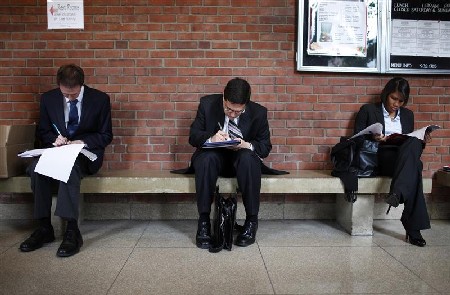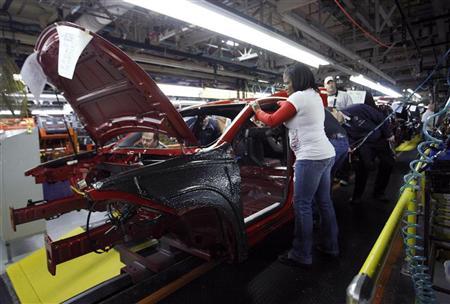 | « Back to article | Print this article |
The West moves to revive manufacturing. Why won't India?
Indeed, as the United States struggles to recapture its manufacturing soul, it's clear there are long-term reasons why governments need to ensure a manufacturing base develops and survives.
In his new book, Time to Start Thinking, the Financial Times' Ed Luce wanders Middle America, and delivers to us a story now familiar: of an industrial landscape in decline.
Since Michael Moore's Roger and Me in 1989, we have known that America's industrial belt has rusted. Some blame globalisation, others technical chan#8805 neither is likely to reverse itself.
And yet, manufacturing is suddenly central to America's economic revival and to the debates in its presidential campaign.
The United States does not stand alone in reassessing how government interacts with manufacturing. Across the developed world, only Westminster's Conservatives, the last lovers of finance, continue to be without an industrial policy.
Click HERE to read further...
The West moves to revive manufacturing. Why won't India?
This trend was first noted in the aftermath of the vastly increased state intervention that marked the response to the 2008 financial crisis. Governments began to distrust finance-heavy economies, and were pressured by voters to somehow "create" middle-class jobs. The countries that survived were those, like Germany and China, that still made actual things. The obvious lessons were drawn.
Yet we stayed in the realm of policy pronouncements and election speeches till recently. As always, it takes a push from the real economy to actually put ideas to work. Suddenly, growing US manufacturing -- especially chemicals -- is a reason for Washington to impose an unprecedented bar on energy exports.
And China -- battered by its export markets' weaknesses, facing union revolts across the Pearl River delta, struggling to increase consumption demand -- is beginning to realise its coasts may not stay forever the workshops of the world.
The energy component of Chinese exports is higher than for most economies, and will only increase relative costs. Earlier this year, China hiked its minimum wages by 13.6 per cent in response to sustained labour unrest. This takes China's minimum wage to three times Vietnam's.
Click HERE to read further...
The West moves to revive manufacturing. Why won't India?
But the most important reason is this: the glorious high-water mark of the diffuse supply chain is behind us. Crude oil prices, over the past decade, have risen fivefold, and permanently.
And the standard rule of thumb is that a dollar more for a barrel of oil increases the cost of freight transport by a percentage point. The cost of shipping a container across the Pacific has more than tripled in the past six years, and many major shipping lines have reduced their cruising speed, too, in order to save fuel.
Meanwhile, the destination of those giant blue containers from Chinese ports, the United States, has discovered shale gas reserves that will ensure that, by most estimates, US gas prices just double in 40 years. Before the discoveries, it was expected that they would increase maybe six or seven times. PricewaterhouseCoopers expects the US will create a million jobs and save $11.6 billion in costs over the next three presidential terms.
Click HERE to read further...
The West moves to revive manufacturing. Why won't India?
The economic logic that led many to assume that networks had gotten simply too complicated and far-flung for national governments to manage will, now, begin to fray slightly. Across the world, governments are retooling their attitude to the manufacturing sector, stepping in to lend, to acquire land, to protect and to lobby internationally. In spite of its dismal record with industrial policy, India's cannot be an exception.
Of course, the nostalgic West cannot expect a return to the comfortable suburban 1950s -- not unless they're willing to let go of their iPhones, that is. Wage expectations and workforce skills are just too different now in most places.
Indeed, as the United States struggles to recapture its manufacturing soul, it's clear there are long-term reasons why governments need to ensure a manufacturing base develops and survives.
Click HERE to read further...
The West moves to revive manufacturing. Why won't India?
China's current experience is, indeed, illustrative: a rise in costs isn't enough to make it uncompetitive. The effects of a local economy geared towards manufacturing ensure that companies are thinking twice about moving -- and even if they do, they're more likely to move to inland China or to neighbouring countries.
The fast-moving conception of the global economy, in which manufacturing moves from destination to destination in search of lower wages, founders on the rock of path-dependence. A manufacturing sector is not easy to set up. And it is even harder to set up twice.
That's a particular problem for India. The state's attitude to manufacturing has been a disorganised shambles throughout the reform years. Before 1991, inefficient attempts at import substitution priced both capital and imported inputs too cheaply; many units were rendered unprofitable when the inevitable crisis forced an end to government control of interest rates and the rupee.
Click HERE to read further...
The West moves to revive manufacturing. Why won't India?
Yet this was not accompanied by robust industrial reform -- of bankruptcy, or of labour law. (Ridiculously, we tried to sell our -- perforce -- services-led growth as a strength and a model.) India's policy makers found they could afford to sit back, liberalise a few export norms, and ride the globalisation wave.
The only numbers that industrial growth has been reduced to in this country, for far too long, are the number of MoUs signed and the (much lower) amount of foreign direct investment those MoUs become.
There is a great cost to allowing this lackadaisical attitude to persist; and there are good reasons why this is the moment that the change must come.
The first, most obvious point is that India needs jobs. The service sector is a sponge -- it contains millions of jobs that people simply don't want to do, but are being forced into because they don't have any other options.
Click HERE to read further...
The West moves to revive manufacturing. Why won't India?
Never in economic history has a country reached middle-class prosperity without a thriving manufacturing sector picking up people who can't be employed by agriculture any more. India will not be an exception, however much we may claim it can be. As the much-talked about youth bulge hits us, there had better be jobs to fit their aspirations.
And this moment, when China's great project to build everything for everybody stutters and slows, and when the rupee is 60 per cent cheaper against the yuan than it was in 2006, is precisely when we need to step up.
For 10 years, there have been no Indian-made locks, toys, hairbrushes in our markets. That has to change. The numbers in the New Manufacturing Policy are incredibly ambitious; 100 million jobs, growth at three per cent faster than the rest of the economy.
And yet it has been allowed to founder before it begins, on typically obdurate objections from the labour ministry and the environment ministry. India cannot afford to delay, or it will lose this crucial historical moment.







